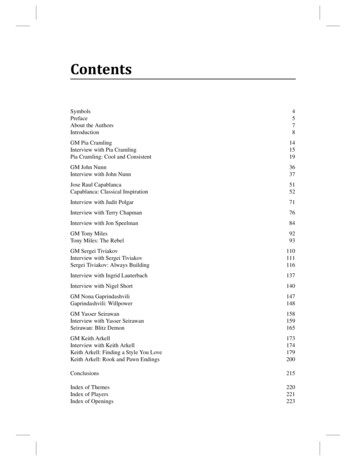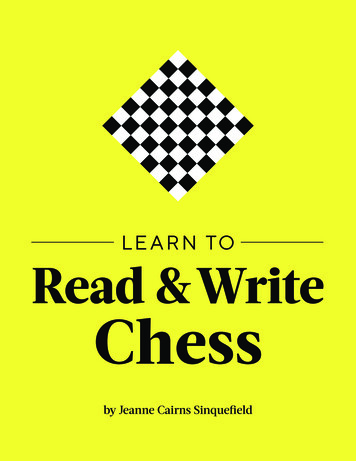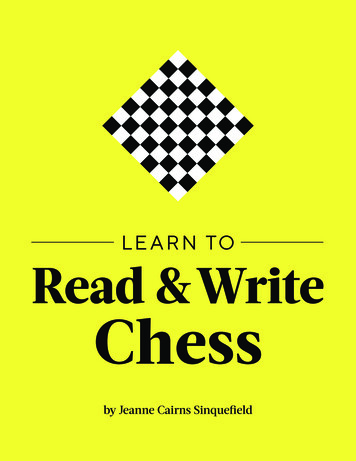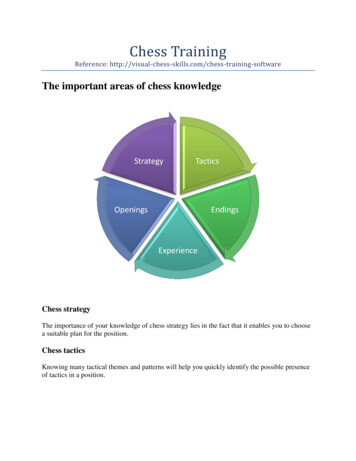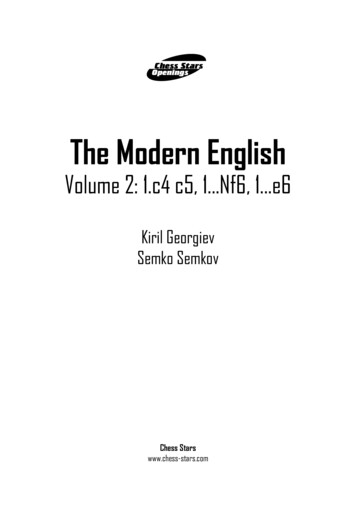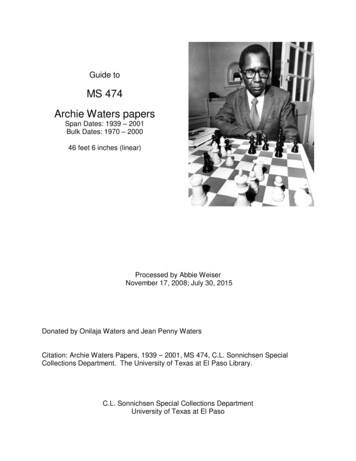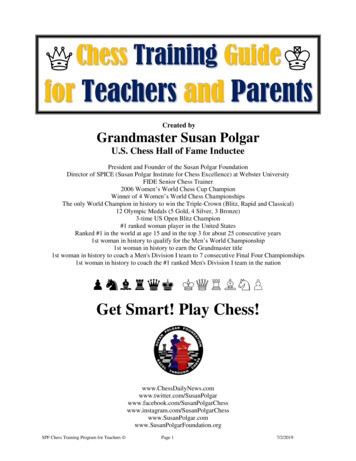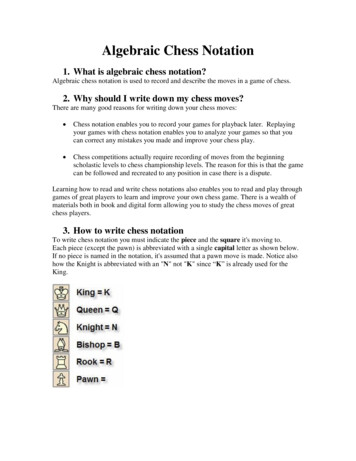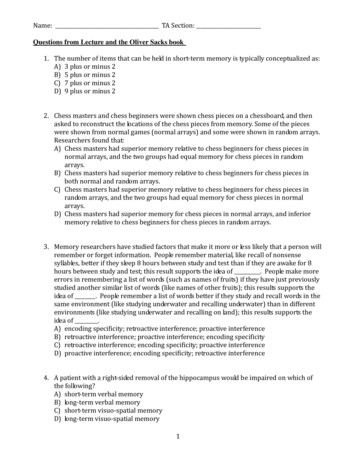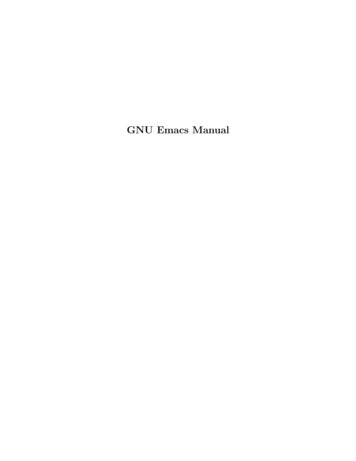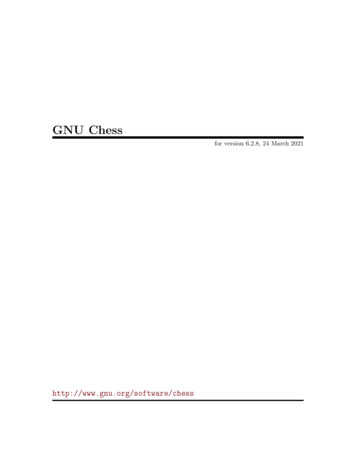
Transcription
GNU Chessfor version 6.2.8, 24 March 2021http://www.gnu.org/software/chess
This manual is for GNU Chess (version 6.2.8, 24 March 2021), which is a complete chessprogram, frequently used as a chess engine.Copyright c 2001–2021 Free Software Foundation, Inc.Permission is granted to copy, distribute and/or modify this document underthe terms of the GNU Free Documentation License, Version 1.3 or any laterversion published by the Free Software Foundation; with no Invariant Sections,with no Front-Cover Texts, and with no Back-Cover Texts. A copy of the licenseis included in the section entitled “GNU Free Documentation License”.
iTable of Contents1Overview . . . . . . . . . . . . . . . . . . . . . . . . . . . . . . . . . . . . . . . . 12Contact info . . . . . . . . . . . . . . . . . . . . . . . . . . . . . . . . . . . . . 23Running gnuchess . . . . . . . . . . . . . . . . . . . . . . . . . . . . . . . 33.13.23.33.43.5Invoking gnuchess . . . . . . . . . . . . . . . . . . . . . . . . . . . . . . . . . . . . . . . . . . . . . . 3Interactive game . . . . . . . . . . . . . . . . . . . . . . . . . . . . . . . . . . . . . . . . . . . . . . . 4Command list . . . . . . . . . . . . . . . . . . . . . . . . . . . . . . . . . . . . . . . . . . . . . . . . . . 4Environment variables . . . . . . . . . . . . . . . . . . . . . . . . . . . . . . . . . . . . . . . . . . 7Configuration file. . . . . . . . . . . . . . . . . . . . . . . . . . . . . . . . . . . . . . . . . . . . . . . 73.5.1 Structure. . . . . . . . . . . . . . . . . . . . . . . . . . . . . . . . . . . . . . . . . . . . . . . . . . 73.5.2 Options . . . . . . . . . . . . . . . . . . . . . . . . . . . . . . . . . . . . . . . . . . . . . . . . . . . 83.5.3 Workarounds . . . . . . . . . . . . . . . . . . . . . . . . . . . . . . . . . . . . . . . . . . . . . 113.6 Output files . . . . . . . . . . . . . . . . . . . . . . . . . . . . . . . . . . . . . . . . . . . . . . . . . . . 123.7 XBoard chess engine . . . . . . . . . . . . . . . . . . . . . . . . . . . . . . . . . . . . . . . . . . 133.8 UCI chess engine . . . . . . . . . . . . . . . . . . . . . . . . . . . . . . . . . . . . . . . . . . . . . . 133.9 Internet . . . . . . . . . . . . . . . . . . . . . . . . . . . . . . . . . . . . . . . . . . . . . . . . . . . . . . . 134Book . . . . . . . . . . . . . . . . . . . . . . . . . . . . . . . . . . . . . . . . . . . . 145Tests . . . . . . . . . . . . . . . . . . . . . . . . . . . . . . . . . . . . . . . . . . . . 156Auxiliary file formats . . . . . . . . . . . . . . . . . . . . . . . . . 167History . . . . . . . . . . . . . . . . . . . . . . . . . . . . . . . . . . . . . . . . . 178Known problems . . . . . . . . . . . . . . . . . . . . . . . . . . . . . . 188.19Adapter . . . . . . . . . . . . . . . . . . . . . . . . . . . . . . . . . . . . . . . . . . . . . . . . . . . . . . 18Developers . . . . . . . . . . . . . . . . . . . . . . . . . . . . . . . . . . . . . 199.19.29.39.49.59.6Background of v6 . . . . . . . . . . . . . . . . . . . . . . . . . . . . . . . . . . . . . . . . . . . . .Guidelines followed to develop GNU Chess v6 . . . . . . . . . . . . . . . . .Chess engine protocol adapter . . . . . . . . . . . . . . . . . . . . . . . . . . . . . . . . .Structure of the source code . . . . . . . . . . . . . . . . . . . . . . . . . . . . . . . . . . .C/C coexistence . . . . . . . . . . . . . . . . . . . . . . . . . . . . . . . . . . . . . . . . . . .Chess engine . . . . . . . . . . . . . . . . . . . . . . . . . . . . . . . . . . . . . . . . . . . . . . . . . .9.6.1 Fruit overview. . . . . . . . . . . . . . . . . . . . . . . . . . . . . . . . . . . . . . . . . . . .9.6.2 Board data structure . . . . . . . . . . . . . . . . . . . . . . . . . . . . . . . . . . . . .9.6.3 Search algorithm . . . . . . . . . . . . . . . . . . . . . . . . . . . . . . . . . . . . . . . . .9.6.4 Transposition table . . . . . . . . . . . . . . . . . . . . . . . . . . . . . . . . . . . . . . .19191920202121212121
ii9.6.59.6.69.6.79.6.810Null move . . . . . . . . . . . . . . . . . . . . . . . . . . . . . . . . . . . . . . . . . . . . . . . .Move ordering. . . . . . . . . . . . . . . . . . . . . . . . . . . . . . . . . . . . . . . . . . . .Evaluation function . . . . . . . . . . . . . . . . . . . . . . . . . . . . . . . . . . . . . .Speed . . . . . . . . . . . . . . . . . . . . . . . . . . . . . . . . . . . . . . . . . . . . . . . . . . . .22222222Translations . . . . . . . . . . . . . . . . . . . . . . . . . . . . . . . . . . 23Appendix A GNU Free Documentation License. . . . . . . . . . . . . . . . . . . . . . . . . . . . . . . . . . . . . . . . . . . . . . . . 24Concept index . . . . . . . . . . . . . . . . . . . . . . . . . . . . . . . . . . . . . 32
Chapter 1: Overview11 OverviewGNU Chess (http://www.gnu.org/software/chess/) is a computer program for playingchess. It can be used to interactively play chess on a text terminal, but it is more oftenused in conjunction with a GUI program such as GNU XBoard.Because it is protected by the GNU General Public License, users are free (in perpetuity)to share and change it.The main author of GNU Chess version 6 is Fabien Letouzey, The original author isStuart Cracraft.
Chapter 2: Contact info22 Contact infoWe are the GNU Chess developers and you may reach us at:bug-gnu-chess@gnu.orgOur official web page is:http://www.gnu.org/software/chessWe are indebted to our sponsor, the Free Software Foundation whose web page is:http://www.fsf.organd which also serves as our software depository for new versions of GNU and GNUChess.You can download the latest version from GNU’s FTP site at:ftp://ftp.gnu.org/gnu/chess/The code is provided for the purpose of encouraging you to do the programming. If youlack the programming skills to do so, try dabbling in it. You might surprise yourself.If you want to report a possible bug in GNU Chess, please send a message to the e-mailaddress indicated above, providing precise information about the conditions that led to thepossible bug. As a general guideline, you can kindly include the follow information: Version of the program. The following command will print it:gnuchess --version How you started the program. Whether running standalone or in combination withother programs such as XBoard. The actions you performed and the output or behaviour you observed. Output files if any. In order to enable the writing to adapter.log, set the followingoption in config file gnuchess.ini:Log true Whether the problem is systematic (it always happens) or occasional. Any other information you may deem relevant.
Chapter 3: Running gnuchess33 Running gnuchess3.1 Invoking gnuchessThe format for running the gnuchess program is:gnuchess option .With no options, gnuchess starts in interactive mode and it is ready to start a chessgame.gnuchess supports the following options:--help-hPrint an informative help message on standard output and exit successfully.--version-vPrint the version number and licensing information of Hello on standard outputand then exit successfully.--quiet--silent-q--xboard-xMake the program silent on startup.Start the program in xboard mode, i.e. as an xboard engine. This is typicallyused for using the program as backend of other chess GUI such as XBoard.Option xboardis accepted without leading dashes for backward compatibility.--post-pStart up showing thinking.Option postis accepted without leading dashes for backward compatibility.--easy-eDisable thinking in opponent’s time. By default, the program runs in hardmode, i.e. it uses opponent’s time to think too.--manual-mEnable manual mode.--uci-uEnable UCI protocol (externally behave as UCI engine).--memory size-M sizeSpecify memory usage in MB for hashtable.--addbook filename-a filenameCompile book.bin from pgn book ’filename’ and quits.--graphic-gEnable graphic mode based on Unicode chess symbols.
Chapter 3: Running gnuchess43.2 Interactive gameMoves are accepted either in standard algebraic notation (SAN) or in coordinate algebraicnotation. Examples:Nf3g1f3O-Oe1g13.3 Command listgnuchess supports the following commands: CQuit the program.quitQuit the program.exitIn analysis mode this stops analysis, otherwise it quits the program.helpProduces a help blurb corresponding to this list of commands.usageProduce blurb on command line options.(Same as gnuchess --help)bookHandle the book. Requires a subcommand:add - compiles book.bin from book.pgnon - enables use of bookoff - disables use of bookbest - play best move from bookworst - play worst move from bookrandom - play any move from bookprefer (default) - choose a good move from book (Method subject to variation)versionPrints out the version of this program(Same as gnuchess --version)pgnsave FILENAMESaves the game so far to the file from memorypgnload FILENAMELoads the game in the file into memory (cf. pgnreplay)pgnreplay FILENAMELoads the game in the file into memory, and enables commands first, last, next,previous. This allows replaying a saved game step by step. (cf. pgnload)firstGo to start position of pgn loaded game with pgnreplay.lastGo to last position of pgn loaded game with pgnreplay.nextAdvances one move in pgn loaded game with pgnreplay.nAdvances one move in pgn loaded game with pgnreplay.
Chapter 3: Running gnuchesspreviousBack one move in pgn loaded game with pgnreplay.pBack one move in pgn loaded game with pgnreplay.forcemanual5Makes the program stop moving. You may now enter moves to reach someposition in the future.(Same as gnuchess --manual)whiteProgram plays black, set white to move.Note: not implemented in this version.blackProgram plays white, set black to move.(White and black commands are mainly for icsDrone and will cause the currenten-passant capture square to be forgotten).Note: not implemented in this version.goComputer takes whichever side is on move and begins its thinking immediatelyeasyDisables thinking on opponent’s time(Same as gnuchess --easy)hardEnables thinking on opponent’s timepostArranges for verbose thinking output showing variation, score, time, depth, etc.If pondering (see hard) is on, the program will output it’s thinking whilst theopponent is thinking.(Same as gnuchess --post)nopostTurns off verbose thinking outputname NAME Lets you input your name. Also writes the log.nnn and a correspondinggame.nnn file. For details please see auxillary file format sections.resultMostly used by Internet Chess server.activateThis command reactivates a game that has been terminated automatically dueto checkmate or no more time on the clock. However, it does not alter thoseconditions. You would have to undo a move or two or add time to the clockwith level or time in that case.Note: not implemented in this version.rating COMPUTERRATING OPPONENTRATINGInputs the estimated rating for computer and for its opponentnewSets up new game (i.e. positions in original positions)timeInputs time left in game for computer in hundredths of a second. Mostly usedby Internet Chess server.otimInputs time left in game for opponent in hundredths of a second. Mostly usedby Internet Chess server.
Chapter 3: Running gnuchess6randomRandomizes play by perturbing the evaluation score slightly. The degree ofperturbation is adjustable.Note: not implemented in this version. Neither in v5hashon - enables using the memory hash table to speed searchoff - disables the memory hash tablememory NSets the hash table to permit storage of N MB.nullon - enables using the null move heuristic to speed searchoff - disables using the null move heuristicxboardon - enables use of xboard/winboardoff - disables use of xboard/winboard(Same as gnuchess --xboard)depth NSets the program to look N ply (half-moves) deep for every search it performs.If there is a checkmate or other condition that does not allow that depth, thenit will not belevel MOVES MINUTES INCREMENTSets time control to be MOVES in MINUTES with each move giving an INCREMENT (in seconds, i.e. Fischer-style clock).loadepdloadLoads a position in EPD format from disk into memory.saveepdsaveSaves game position into EPD format from memory to disk.switchSwitches side to moveNote: not implemented in this version.solve FILENAMEsolveepd FILENAMESolves the positions in FILENAMEremoveBacks up two moves in game historyundoBacks up one move in game historyshowRequires a subcommand:board - displays the current boardtime - displays the time settingsmoves - shows all moves using one call to routineescape - shows moves that escape from check using one call to routinenoncapture - shows non-capture movescapture - shows capture moveseval [or score] - shows the evaluation per piece and overallgame - shows moves in game historypin - shows pinned piecesNote: ’show eval’ and ’show pin’ not implemented in this version.
Chapter 3: Running gnuchess7testRequires a subcommand:movelist - reads in an epd file and shows legal moves for its entriescapture - reads in an epd file and shows legal captures for its entriesmovegenspeed - tests speed of move generatorcapturespeed - tests speed of capture move generatoreval - reads in an epd file and shows evaluation for its entriesevalspeed tests speed of the evaluatorNote: not implemented in this version.analyzeSwitches program into analysis mode, this is primarily intended for communicating analysis to an external interface using the Xboard chess engine protocol.It enables "force", "post", and "hard", at the same time, whilst altering theoutput format of post to conform with the engine protocol.graphicEnables graphic mode. In this mode, the board is displayed using the Unicodechess symbols (Codepoints from U 2654 to U 265F). The graphic mode requiresa terminal with Unicode support.(Same as gnuchess --graphic)nographicDisables graphic mode. The board is displayed using the good-old classic viewbased on plain ASCII.3.4 Environment variablesIf GNUCHESS PKGDATADIR is defined, it will be taken as the path for the config file and forthe book, in case the files are not found in the current directory. If it is not defined, theywill be taken from the package data directory, in case the files are not found in the currentdirectory.3.5 Configuration file3.5.1 StructureA file called gnuchess.ini is used to define configuration options. The file is applicableprovided --uci is not used. The file is looked in three places according to the followingprecedence:1. The directory where the program was started2. Environment variableGNUCHESS PKGDATADIR3. The package data directory stated at configure timeSections are composed of variable value lines.Note: There can be spaces in variable names or values. Do not use quotes.[Adapter] sectionThis section is used by the adapter only. The engine is unaware of these options. Thelist of available options is detailed below in this document.[Engine] section
Chapter 3: Running gnuchess8This section contains engine UCI options. The PolyGlot-based adapter does not understand them, but sends the information to the engine at startup (converted to UCI form).You can add any UCI option that makes sense to the engine (not just the common optionsabout hash-table size and tablebases).Note: use INI syntax, not UCI. For example OwnBook true is correct. It will bereplaced by the adapter with setoption name OwnBook value true at engine startup.Standard UCI options are Hash, NalimovPath, NalimovCache and OwnBook. Hiddenoptions like Ponder or UCI xxx are automatic and should not be put in the INI file.3.5.2 OptionsThese should be put in the [Adapter] section.LogDefault: falseWhether the adapter should log all transactions with the interface and theengine. This should be necessary only to locate problems.LogFileDefault: adapter.logThe name of the log file. Note that it is put where the program was launchedfrom, not into the engine directory.WARNING: Log files are not cleared between sessions, and can become verylarge. It is safe to remove them though.ResignDefault: falseSet this to "true" if you want the adapter to resign on behalf of the engine.NOTE: Some engines display buggy scores from time to time although the bestmove is correct. Use this option only if you know what you are doing (e.g. youalways check the final position of games).ResignMovesDefault: 3Number of consecutive moves with "resign" score (see below) before the adapterresigns for the engine. Positions with only one legal move are ignored.ResignScoreDefault: 600This is the score in centipawns that will trigger resign "counting".ShowPonderDefault: trueShow search information during engine pondering. Turning this off might bebetter for interactive use in some interfaces.KibitzMoveDefault: falseWhether to kibitz when playing a move.KibitzPVDefault: falseWhether to kibitz when the PV is changed (new iteration or new best move).
Chapter 3: Running gnuchess9KibitzCommandDefault: tellallxboard command to use for kibitzing, normally "tellall" for kibitzing or "tellothers" for whispering.KibitzDelayDefault: 5How many seconds to wait before starting kibitzing. This has an affect only if"KibitzPV" is selected, move kibitzes are always sent regardless of the delay.BookDefault: falseIndicates whether the adapter should use a book. This has no effect on theengine own book (which can be controlled with the UCI option OwnBook in the[Engine] section). In particular, it is possible to use both a PolyGlot book andan engine book. In that case, the engine book will be used whenever PolyGlotis out of book. Remember that PolyGlot is unaware of whether the engine isitself using a book or not.BookFileDefault: book.binThe name of the (binary) book file. Note that PolyGlot will look for it in thedirectory it was launched from, not in the engine directory. Of course, full pathcan be used in which case the current directory does not matter.If the file is not found in the current directory, it will be looked for inGNUCHESS PKGDATADIR if the variable is defined, or in the package datadirectory otherwise.Note that there is no option to control book usage. All parameters are fixedwhen compiling a PGN file into a binary book (see below). This is purposefuland is not likely to change.Using a book does not require any additional memory, this can be importantfor memory-limited tournaments.These are UCI options for the [Engine] section:NullMove Pruning(Always/Fail High/Never)Default: Fail High"Always" actually means the usual conditions (not in check, etc .). "Fail High"adds the condition that the static evaluation fails high. Never use "Never"(ever)! OK you can use "Never" to test a Zugzwang problem.I expect that this option has little effect (assuming the first two choices only).It was only added because most engines do not use the fail-high condition.NullMove Reduction(1-3 plies)Default: 33 is rather aggressive, especially in the endgame. It seems better than alwaysusing 2 though.
Chapter 3: Running gnuchess10Verification Search(Always/Endgame/Never)Default: EndgameThis tries to solve some Zugzwang-related problems. It is expected to hardlyhave any effect in games. The default value should be sufficient for mostcommon Zugzwang situations.Verification Reduction(1-6 plies)Default: 55 guarantees that the cost of verification search is negligible in most cases. Ofcourse it means Zugzwang problems need a lot of depth to get solved, if ever!With such a reduction, verification search is similar to Vincent Diepeveen’s"double null move".History Pruning(true/false)Default: trueA bit dodgy, but fun to experiment with. It should help in blitz, but it’s possibleit actually hurts play in longer games.History Threshold(percentage)Default: 60%This is the thing, as it affects the search tree! Lower values are safer, and highervalues more aggressive. THIS VALUE HAS NOT BEEN TUNED! There is agood chance Fruit’s strength can be improved by changing this option.Futility Pruning(true/false)Default: falseVery common but controversial. Makes the engine a tiny bit better at tacticsbut slightly weaker positionally. It might be beneficial by a very small amount,but has not been tested in conjunction with history pruning yet.Futility Margin(centipawns)Default: 100This value is somewhat aggressive. It could lead to problems in the endgame.Larger values prune less but will lead to fewer positional errors.Delta Pruning(true/false)Default: falseSimilar to futility pruning. Probably safer because it is used mainly during themiddlegame. Has not been tested with history pruning either.
Chapter 3: Running gnuchess11Delta Margin(centipawns)Default: 50Same behaviour as futility margin. This one is probably safe.Quiescence Check Plies(0-2 plies)Default: 1Fruit tries safe (SEE 0) checks at the first plies of the quiescence search. 0means no checks at all (as in most older engines). 1 is the same as previousversions of Fruit. 2 is probably not worth the extra cost. It could be interestingwhen solving mate problems though.Evaluation options(percentage)Default: 100%These options are evaluation-feature multipliers. You can modify Fruit’s playingstyle to an extent or make Fruit weaker for instance by setting "Material" to alow value."Material" is obvious. It also includes the bishop-pair bonus. "Piece Activity":piece placement and mobility. "King Safety": mixed features related to theking during early phases "Pawn Structure": all pawn-only features (not passedpawns). "Passed Pawns": . can you guess?The following options were used in PolyGlot v1.4, but are deprecated in GNU Chess:EngineNameDefault: GNU ChessThis is the name that will appear in the xboard interface. It is cosmetic only.You can use different names for tweaked versions of the same engine.If no "Engine Name" is given, the UCI name will be used.EngineDirDefault: .Full path of the directory where the engine is installed. You can use "." (withoutthe quotes) if you know that PolyGlot will be launched in the engine directoryor the engine is in the "path" and does not need any data file.EngineCommandPut here the name of the engine executable file. You can also add commandline arguments. Path searching is used and the current directory will be "EngineDir".NOTE: Unix users are recommended to prepend "./"; this is required on somesecure systems.3.5.3 WorkaroundsWork arounds are identical to options except that they should be used only when necessary.Their purpose is to try to hide problems with various software (not just engines). Thedefault value is always correct for bug-free software.
Chapter 3: Running gnuchess12These workarounds are unlikely to be used or meaningful for GNU Chess.UCIVersionDefault: 2The default value of 2 corresponds to UCI . Use 1 to select plain UCI forengines that have problems with UCI .CanPonderDefault: falseThe adapter now conforms to the documented UCI behaviour: the engine willbe allowed to ponder only if it (the engine) declares the Ponder UCI option.However some engines which can actually ponder do not declare the option.This work around lets The adapter know that they can ponder.SyncStopDefault: falseWhen a ponder miss occurs, the adapter interrupts the engine and immediatelylaunches a new search. While there should be no problem with this, someengines seem confused and corrupt their search board. SyncStop forces theadapter to wait for the (now useless) ponder search to finish before launchingthe new search.PromoteWorkAroundDefault: falseSome engines do not specify a promotion piece, e.g. they send "e7e8" insteadof the correct "e7e8q". This work around enables the incorrect form (and ofcourse promotes into a queen).3.6 Output filesGNU Chess produces several output files:Adapter log fileThis file is written by the adapter. The name of the file is specified by thefollowing option in gnuchess.ini:LogFile FILENAMEThe file is produced if option --uci is not specified and if the following variableis set in gnuchess.ini:Typically, this file is named adapter.log, but any other name will do the job.Log truelog.nnnThis file is written if command name was requested. The contents are theopponent’s name and the game in coordinate algebraic notation.game.nnnThis file is written if command name was requested. The contents are theopponent’s name and the game in portable game notation (PGN).players.datThis file is written if command name was requested. The contents are thestatistics of games. This is the format of each line:opponent-name wins loses draws
Chapter 3: Running gnuchess13gnuchess.debugThis file contains internal information that is useful for debugging purposes.For this file to be written, it is necessary to define preprocessor directive DEBUG.Hence, when installing the program, instead of./configuremakemake installUse the following commands:./configure CPPFLAGS -DDEBUGmakemake installWhen analysing a bug, this file could be very helpful. Users are encouraged toprovide it.3.7 XBoard chess engineRunning the program with the "–xboard" command line parameter sets it to produce outputacceptable to and accept input suitable for XBoard, the graphical display front-end withmouse interface.For historical reasons the option "xboard" does not need to be preceeded by "–"; howeverwe would encourage the new syntax.How to run XBoard with GNU Chess as backend (first chess engine):xboard -fcp ’gnuchess --xboard’xboard -fd . -fcp ’./gnuchess --xboard’How to run XBoard with GNU Chess playing against itself:./xboard -fcp ’./gnuchess -x’ -fd . -scp ’./gnuchess -x’ -sd . -pieceImageDirectory ’sv3.8 UCI chess engineFor GNU Chess to behave as a pure UCI chess engine, execute the following command:gnuchess --uciIn this mode, configuration file gnuchess.ini is ignored.3.9 InternetFor GNU Chess to run in Internet, Zippy is required. See Zippy documentation in theXBoard/WinrBoard distribution:http://www.tim-mann.org/this is an example of how to run GNU Chess on FICS using XBoard as frontend andZippy as connector:xboard -zp -ics -icshost freechess.org -icshelper timeseal -fcp ’gnuchess --xboard’
Chapter 4: Book4 BookSee options Book and Bookfile in Running GNU Chess - Configuration file - Options14
Chapter 5: Tests155 TestsGNU Chess 6 has been tested on the Free Internet Chess Server (http://www.freechess.org) with XBoard.
Chapter 6: Auxiliary file formats166 Auxiliary file formats.binbinary book format.pgngame listing like 1. e4 e5 2. Nf3 etc.epdepd-style format using FEN notation. See tests subdirectory for example.log.nnnrecord of an entire game from computer’s viewpoint (thinking, etc.)game.nnnrecord of an entire game, similar to .pgn but auto-generatedThe .bin file format is a simple binary format for the compiled book which is read bythe program when it is using book. See the book section for more detail.EPD and PGN require little introduction. These are the uniformly accepted standardsfor position recording and game recording.Note that log.nnn and game.nnn files are written at the end of a game when you usethe name command to give the computer your name. It is highly recommended to do thissince the resulting two files that match in a monotonically-increasing extension numberedsuffix may be used for reporting bugs and keeping track of your games.
Chapter 7: History177 HistoryThe first version of GNU Chess was written by Stuart Cracraft back in 1984. Versions from2 to 4 were written by John Stanback. Version 5 was written by Chua Kong-Sian. Version6 was written by Fabien Letouzey.
Chapter 8: Known problems188 Known problems8.1 AdapterThese are known problems of PolyGlot v1.4 as described by Fabien Letouzey.The addition of Chess960 support lead to a change in internal-move representation forcastling. This slightly affected the opening-book format. We recommend that you recompilebooks with this version.Several users reported engines losing on time. The playing conditions always mixedplaying on an Internet server with pondering.It is not yet clear what the source of the problem is, but there seems to be a forever incompatibility between the xboard and UCI protocol regarding a complex pondering/remainingtime relation.
Chapter 9: Developers199 Developers9.1 Background of v6Since version 5.07 of the program was released in 2003, GNU Chess has basically remainedunchanged. Then Fabien Letouzey developped Fruit, which proved to be a stronger chessengine and shaked the computer chess world. At some point in time, he kindly assignedcopyright to FSF, which allowed us to make Fruit 2.1 (the latest free version) the base forGNU Chess v6.Therefore, it can be fairly said that Fabien Letouzey is remarkably the main contributorto GNU Chess v6.9.2 Guidelines followed to develop GNU Chess v6The idea was to use Fruit 2.1 as the base for GNU Chess v6, keeping external interfacesbackwards compatible. This is particularly important since GNU Chess has been world-wideused for long.GNU Chess can be used in two modes: interactively using the command-line interfaceon a text console, and used as backend engine from a graphical frontend. Both cases relyon almost identical grammar. The former is described in GNU Chess help.When GNU Chess is used as a pure chess engine, for instance, as backend for XBoard, ituses the Chess Engine Communication Protocol (aka XBoard protocol), which is ine-intf.htmlSince Fruit uses the Universal Chess Interface (UCI), keeping the former interface wasthe main challenge of GNU Chess v6. UCI is described mlGNU Chess can also run as a UCI chess engine, if the --uci command-line option isspecified.9.3 Chess engine protocol adapterUCI is very different from the Chess Engine Communication Protocol. PolyGlot is a UCI-toxboard adapter developed by Fabien. It connects a UCI chess engine to an xboard interfacesuch as WinBoard. UCI2WB is another such adapter (for Windows).Standalone PolyGlot can be used, along with Fruit, as chess engine for chess frontends,suchs as XBoard. In that case, PolyGlot and Fruit run as two independent single-thread
It can be used to interactively play chess on a text terminal, but it is more often used in conjunction with a GUI program such as GNU XBoard. Because it is protected by the GNU General Public License, users are free (in perpetuity)
